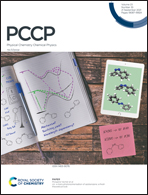Pressure-induced bandgap engineering of lead-free halide double perovskite (NH4)2SnBr6†
Abstract
Lead-free halide double perovskites (HDPs) have recently been proposed as potential stable and environment-friendly alternatives to lead-based halide perovskites. Bandgap engineering plays a vital role in the optoelectronic applications of HDP materials. In this study, methods combining high-pressure techniques with density functional theory calculations were employed to implement the bandgap engineering of a classic HDP-based (NH4)2SnBr6. Under high pressure, (NH4)2SnBr6 exhibits a redshift of the bandgap with increasing pressure up to 6.3 GPa and a sudden blueshift up to 20.2 GPa, followed by a redshift at higher pressures, which is relevant to the cubic–tetragonal phase transition, direct–indirect transition, and amorphization, respectively. Our results enrich the understanding of the structural–optical properties of (NH4)2SnBr6 and reveal the special role of NH4+ cations in pressure-induced bandgap engineering, thus providing important information for application in optoelectronic devices and helping to design ideal materials with higher efficiency.

- This article is part of the themed collection: 2021 PCCP HOT Articles


 Please wait while we load your content...
Please wait while we load your content...